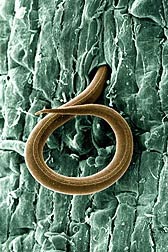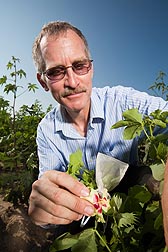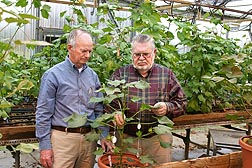The Search for Nematode-Resistant Cotton
Agricultural Research Service scientists in Georgia and Mississippi are helping cotton growers deal with the double-barreled threat posed by two nematode species that lurk in their fields. The root-knot nematode (Meloidogyne incognita) thrives in the sandy soils throughout much of the southern United States and can cause crop losses of up to 10 percent worldwide. The reniform nematode (Rotylenchulus reniformis) is limited to warmer regions of the Cotton Belt, but its range is expanding. It causes an estimated $130 million in losses each year to the U.S. cotton industry. In some areas, crop losses caused by the reniform nematode are as high as 75 percent, depending on weather conditions. Losses are greatest under drought stress that typically occurs from midsummer to early fall.
Plant breeders have struggled to develop resistant lines in part because cotton has a diverse and complicated genome—some plants have two sets of chromosomes and some have four—making it difficult to cross “wild” resistant germplasm with commercial cultivars and come up with a hybrid that will produce seed. Developing lines resistant to root-knot nematode has been particularly challenging because resistance is a multi-gene trait, and that makes developing a resistant cultivar time consuming and extremely expensive.
ARS efforts have attracted support from cotton growers looking for environmentally friendly ways to repel soil pests. “Our best hope for future management of nematodes is to achieve through plant breeding much of what we are now doing with chemical treatments,” says Robert Nichols, senior director for Cotton Incorporated, which is funding much of the work.
The research has taken on a sense of urgency because a pesticide widely used to control nematodes in cotton fields, Temik, is in short supply and is scheduled to be discontinued in the years ahead because of health and environmental concerns. The phase-out of the pesticide, also known as “aldicarb,” is “prodding everyone working in this area to step lively,” Nichols says.
Eliminating undesirable traits in cotton is a team effort in which researchers essentially “pass the baton” to plant breeders to develop commercial varieties. Scientists use molecular tools to link nematode resistance with certain patterns in the plant’s DNA, and those patterns are referred to as “markers.” Researchers provide new cotton lines with those markers to plant breeders and they use them to screen for resistance based on the markers, crossing plants that have them with adapted commercial lines. This process eventually leads to lines with both resistance and the desirable traits inherited from commercial varieties.
ARS researchers are making it easier for breeders to develop commercially acceptable materials by transferring resistance genes from wild plants into cotton cultivars and releasing the resulting lines as breeding tools. They are also developing molecular markers to speed up identification of key nematode-resistance genes. Much of the research is focused on upland cotton (Gossypium hirsutum), which is native to Mexico and Central America and is one of two principal types of cotton, making up more than 95 percent of U.S. production.
“Finding genetic markers is critical if we want cotton breeders and private companies to get involved and begin developing commercial varieties with nematode resistance,” says Richard Davis, an ARS plant pathologist at the Coastal Plain Experiment Station in Tifton, Georgia.
|
|
Davis and colleagues at the University of Georgia have released a root-knot-nematode-resistant line for breeders to work with, and they are hunting for additional genetic markers that will open pathways toward development of commercially viable resistant lines.
Davis has been focused on combating nematode resistance for years. In 2006 he and Peng Chee, his University of Georgia partner, published a paper that identified areas of the cotton genome where root-knot resistance genes are likely to reside. They have since refined the search by mapping portions of the chromosome where the resistance genes are located and identifying “flanking markers” that lie on either side of the genes themselves. These results, published in Theoretical Applied Genetics, will be critical in the search for the specific genes that confer resistance to nematodes.
Their new line is the result of several years of field trials where researchers evaluated crosses among cotton plants, some raised in fields inoculated with the nematode and others raised in fields free of it. The new line is susceptible to the reniform nematode and is not intended as a commercial cultivar. But it is an excellent tool for breeders and provides a source of resistance to root-knot nematode, along with yields higher than and quality superior to a breeding line released in 1989 and still used in many field trials as a research standard. Davis released the new line in a recent report in the Journal of Plant Registrations.
“What makes this release significant is that it has extremely good fiber quality, it resists the root-knot nematode, and it can grow all over the southeastern United States,” Davis says.
Developing Cotton That Resists Both Nematodes
At the Crop Genetics Research Unit in Stoneville, Mississippi, ARS plant pathologist Sally Stetina and plant geneticist John Erpelding are conducting a program to insert genes for reniform nematode resistance into cultivated upland cotton varieties. Those resistance genes will come from several distant relatives: G. aridum, G. arboreum, G. herbaceum, and G. barbadense.
But crossing cultivated cotton with its distant cousins isn’t easy, mainly because of chromosomal incompatibilities.
“Upland cotton is tetraploid—meaning it has four sets of chromosomes—and most of the related species with reniform nematode resistance are diploid, having two sets of chromosomes,” explains Stetina. “When you cross these directly, you get a triploid hybrid, a plant with three sets of chromosomes that is sterile; it will not set seed, and the resistance you moved in will never be passed to the next generation.”
The researchers’ solution was to create an intermediary cotton strain, known as a “bridging line,” using a series of complicated procedures, including embryo rescue and chromosome doubling. Its express purpose is to serve as a bridge between species so that genes for reniform nematode resistance can be passed from cotton’s distant relatives into cultivated varieties or germplasm lines used to breed them. However, says Stetina, “When you bring in resistance from the related species, you can introduce undesirable traits such as smaller bolls, limited flowering, poor fiber quality, and poor performance under typical U.S. crop conditions. That’s why additional crosses with adapted lines that have desirable agronomic traits are critical to getting the right combination of resistance and crop performance.”
Markers provide an important tool to track resistance over multiple generations of crossing to ensure successful transfer, Erpelding adds.
Erpelding and Stetina aim to develop markers associated with reniform nematode resistance in G. arboreum and G. herbaceum and make them available to breeders. Markers are already available for reniform nematode resistance from G. longicalyx, G. aridum, and G. barbadense sources. These were developed by teams of researchers from ARS, Texas A&M University, Mississippi State University (MSU), Cotton Incorporated, and Monsanto Company, Stetina says.
Depending on the field in which it is grown, cotton can be attacked by many different nematodes, so varieties with resistance to two or more nematode species can be beneficial. In Mississippi, reniform nematode and root-knot nematode are the biggest challenges to profitable cotton production.
Stetina and Erpelding have teamed with MSU researchers Peggy Thaxton and Ted Wallace to develop cotton varieties with resistance to the two nematode species by using marker-assisted selection. Offspring from crosses are first selected based on the presence of markers for resistance. Plants that are found to have multiple sources of resistance are directly challenged with the nematodes to confirm the resistance. Advanced lines of upland cotton that resist one or both of the nematode pests may be ready for release in 2 to 4 years.
A Pest for the Past 100 Years
At the ARS Genetics and Precision Agricultural Research Unit in Mississippi State, Mississippi, geneticist Johnie Jenkins and his colleagues have also made significant strides in coming up with nematode-resistant cotton lines.
Root-knot nematode has been recognized as a cotton pest for the past 100 years, according to Jenkins. “Since the 1930s, scientists have been looking for resistance to nematodes. In the 1960s, ARS started research in root-knot nematode resistance in cotton,” says Jenkins. Raymond Shepherd, a retired ARS scientist, was instrumental in using root-knot nematode resistance in a line of wild cotton from Mexico to develop resistant germplasm, he says.
Jenkins and his colleagues found patterns of DNA associated with root-knot nematode resistance and key genetic underpinnings that confer resistance to reniform nematode. The markers they developed for resistance to root-knot nematode in upland cotton—found on chromosomes 11 and 14—should be useful in selecting plants with resistance. They also found that resistance to reniform nematode in a wild G. barbadense line is governed by more than one gene, and they have identified markers linked to these genes on chromosomes 21 and 18. They published separate articles on the root-knot nematode work and the reniform nematode work in Theoretical and Applied Genetics. Former post-doctoral researcher Osman Gutierrez (currently a plant geneticist in ARS’s Subtropical Research Station in Miami, Florida) was the lead author on the paper. Co-authors included Genetics and Precision Agriculture Research Unit colleagues agronomist Jack McCarty, molecular geneticist Martin Wubben, plant physiologist Franklin Callahan, and retired ARS scientist Arin Robinson.
Commercial breeders had steered away from efforts to breed root-knot resistance into upland cotton lines over the years because it was governed by more than one gene and seemed so costly and time-consuming, says ARS agronomist Jack McCarty. But the research contributions from Jenkins and his colleagues may change that due to the use of marker-assisted selection.
“This research has sparked interest from some plant breeding companies in trying to develop high levels of resistance to root-knot and reniform nematode in upland cotton,” he says.—By Dennis O'Brien, Jan Suszkiw, and Sharon Durham, Agricultural Research Service Information Staff.
This research is part of Plant Diseases (#303) and Plant Genetic Resources, Genomics, and Genetic Improvement (#301), two ARS national programs described at www.nps.ars.usda.gov.
To reach scientists mentioned in this article, contact Dennis O’Brien, USDA-ARS Information Staff, 5601 Sunnyside Ave., Beltsville, MD 20705-5129; (301) 504-1624.
"The Search for Nematode-Resistant Cotton" was published in the July 2012 issue of Agricultural Research magazine










